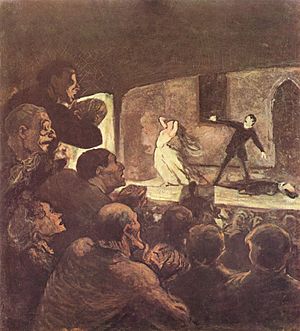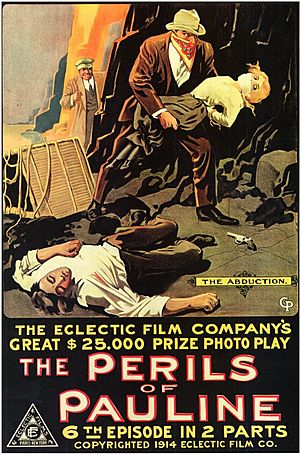Melodrama facts for kids

A melodrama is a type of story, like a play, movie, or TV show, where the plot is often very exciting and aims to create strong emotions. In melodramas, the story's events are usually more important than how deep or complex the characters are. The characters often fit into simple types, like a clear hero or a clear villain.
Melodramas often focus on family life, love, and marriage, with challenges coming from outside, like a tricky person or a mean villain. On stage or screen, melodramas usually have dramatic music that helps the audience feel the emotions of the story.
The word "melodrama" can sometimes be used in a negative way today. It might suggest that a story lacks depth or that the characters are too simple. If someone acts in a very over-the-top, emotional way, we might call their behavior "melodramatic."
Contents
What Does Melodrama Mean?
The word "melodrama" comes from the early 19th-century French word mélodrame. It combines the Greek word mélos, meaning "song" or "melody," and the French word drame, meaning "drama." So, it literally means "song-drama" or "music-drama."
Main Features of Melodrama
Melodramas often show a clear struggle between good and evil. The main characters might be ordinary people caught in amazing situations, or they might be very exaggerated.
A key focus in melodramas is often the victim. This could be a person facing difficult choices, like someone being tempted to leave their family. Other common characters include a single parent, an orphan, or a man struggling with the challenges of modern life.
Melodramas often explore family and social issues within a home setting. They are often made to appeal to audiences who enjoy seeing home tensions get resolved. These stories sometimes look back to an ideal past, highlighting strong feelings and desires.
How Melodrama Started
Early Melodrama History
The idea of melodrama became popular in 18th and 19th-century French romantic plays and sentimental novels. These stories focused on moral rules about family, love, and marriage. They reflected the big changes happening at the time, like the French Revolution and the Industrial Revolution. Many early melodramas were about young middle-class women facing unwanted attention from wealthy troublemakers.
In the 18th century, melodrama was a way of combining spoken words with short pieces of music. The music and spoken dialogue would usually take turns, or sometimes music would play during silent acting.
One of the earliest known examples is Jean-Jacques Rousseau's Pygmalion, first performed in 1770. Other composers like Georg Benda also created successful melodramas. Even Wolfgang Amadeus Mozart used this style in his opera Zaide. Later, famous composers like Ludwig van Beethoven in Fidelio and Carl Maria von Weber in Der Freischütz used melodramatic parts in their operas.
After 1660 in England, many theaters were not allowed to perform "serious" plays. They could only show comedies or plays with music. To get around this rule, other theaters started performing dramas with music playing underneath the dialogue. They borrowed the French term "melodrama" for these shows. This rule changed in 1843, allowing all theaters to perform any type of drama.
19th Century Music and Plays
In the early 1800s, operas influenced many plays to include musical introductions and background music. For example, Franz Schubert wrote a melodrama called Die Zauberharfe ("The Magic Harp") in 1820. Felix Mendelssohn also wrote famous music for Shakespeare's A Midsummer Night's Dream.
In operas, music is often used to highlight spoken words. For instance, in Verdi's La Traviata, a character reads a letter while the orchestra plays music from an earlier love scene. This is a technical example of melodrama in opera.
Victorian plays often had "incidental music" playing during the dialogue. This is similar to how film scores work today. Some operettas, which are lighter operas, also used melodrama. For example, Gilbert and Sullivan's Ruddigore has a short melodramatic part.
In Paris during the 19th century, melodrama was very popular in the many theaters on the Boulevard du Crime. However, most of these theaters were torn down in 1862 during the rebuilding of Paris.
By the late 1800s, "melodrama" often referred to a specific type of home entertainment. This involved spoken words, often poetry, set to music, usually played on a piano. It was sometimes seen as a less serious art form.
Melodrama in Opera
Most operas can be seen as melodramas. The music helps to show and increase the strong emotions. Many opera plots involve characters dealing with huge events like war, betrayal, great love, murder, or revenge. The characters are often drawn simply, with clear good and evil roles. The story's events are set up to best show how they affect the characters' emotions.
Many famous operas, especially those by Gaetano Donizetti, Vincenzo Bellini, Giuseppe Verdi, and Giacomo Puccini, are clear examples of melodrama. Think of heroines like Lucia or Tosca, who face impossible love or grand challenges.
Victorian Melodrama on Stage
Victorian stage melodramas usually had six main characters:
- The hero
- The villain
- The heroine (a young woman in trouble)
- An older parent
- A helpful sidekick
- A servant
These characters were involved in exciting plots often about love and crime. Often, the good but not-so-smart hero would be tricked by a cunning villain. But in the end, good would always win over evil. Two important parts of these plays were the coup de théàtre (a sudden change in fortune) and the claptrap (a powerful speech by the hero that made the audience applaud).
English melodrama grew from older types of plays and was influenced by French and German dramas. The first English play called a "melodrama" was A Tale of Mystery in 1802. Other popular types included Gothic melodramas, with spooky themes, and nautical melodramas, set on ships. Later, melodramas about city life, prisons, and even temperance (avoiding alcohol) became popular.
The exciting novels of the 1860s and 1870s, called "sensation novels," also had many melodramatic features. A famous example is Lady Audley's Secret by Mary Elizabeth Braddon.
The villain was often a very important character in melodrama, and crime was a favorite topic. This included stories about real-life criminals like Sweeney Todd and famous murder cases. Early silent films, like The Perils of Pauline, also had similar themes.
Melodrama Today
Modern Melodrama Around the World
Classic melodrama is less common in Western TV and movies today. However, it is still very popular in other parts of the world, especially in Asia and Hispanic countries. Melodrama is a main type of story in Latin American TV dramas (telenovelas) and in Asian TV dramas from places like South Korea, Japan, and the Philippines. These shows are watched by many people around the globe.
Melodrama in Film
Melodrama films are a type of drama movie known for plots that create strong emotions in the audience. These films often involve emotional problems, broken relationships, family difficulties, sadness, or physical challenges. The characters often include victims, couples, good heroes, and suffering main characters (usually heroines).
These characters face huge social pressures, threats, or problems with friends, family, or work. Following the typical melodrama style, the characters usually work through their difficulties and overcome their problems.
Filmmakers often use flashbacks to show events outside the usual home or small-town settings of melodramatic films.
Female Characters in Melodrama Films
Many melodrama films from the 1930s and 1940s, sometimes called "weepies" or "tearjerkers," were based on stories written for women, like romance novels. Because of this, melodramatic films often focus on female viewpoints and desires.
Famous Melodrama Films
In the 1950s, films by director Douglas Sirk, like All That Heaven Allows (1955), are great examples of the melodrama style. Many later filmmakers were influenced by his work.
In the 1970s, Rainer Werner Fassbinder made melodramas that explored social issues like class differences and racism. More recent melodramas include Todd Haynes' 2002 film Far from Heaven. Contemporary director Pedro Almodovar also gets a lot of ideas from the melodrama style.
See also
 In Spanish: Melodrama para niños
In Spanish: Melodrama para niños
- List of melodrama films
- Legal drama
- Newgate novel
- Pantomime
- Serial (radio and television)
- Soap opera
- Space opera
- Telenovela
- Very special episode
- Woman's film


